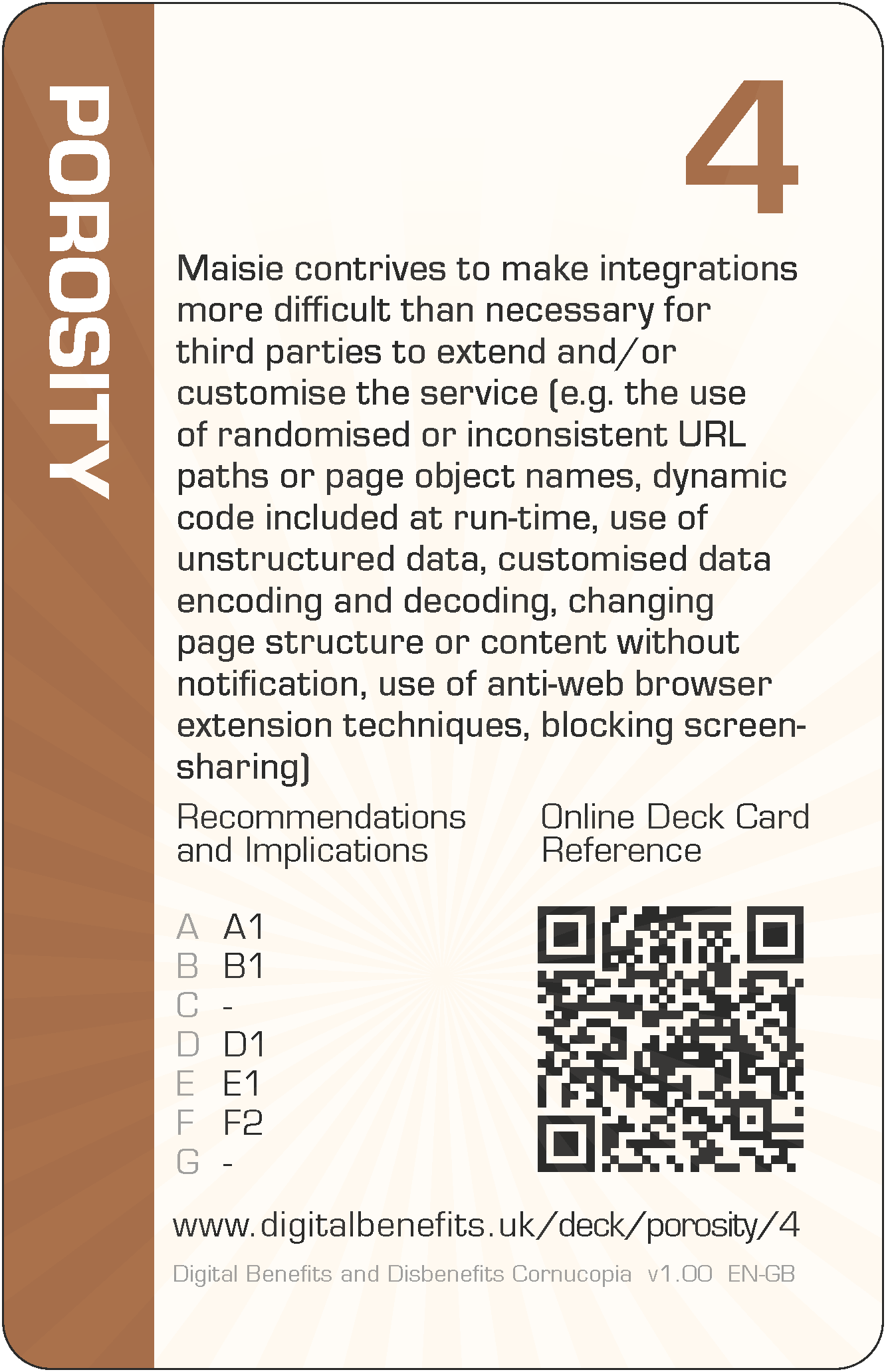Porosity 4 (PO-4) Card
DBD Cornucopia > Deck > Porosity > 4
Card Details - Four of Porosity
Abbreviation
PO-4
Card's focus
The focus of this card is awkward integration
Threat to claimants
Maisie contrives to make integrations more difficult than necessary for third parties to extend and/or customise the service (e.g. the use of randomised or inconsistent URL paths or page object names, dynamic code included at run-time, use of unstructured data, customised data encoding and decoding, changing page structure or content without notification, use of anti-web browser extension techniques, blocking screen-sharing)

Threat to claimants
Maisie contrives to make integrations more difficult than necessary for third parties to extend and/or customise the service (e.g. the use of randomised or inconsistent URL paths or page object names, dynamic code included at run-time, use of unstructured data, customised data encoding and decoding, changing page structure or content without notification, use of anti-web browser extension techniques, blocking screen-sharing).
Some examples of how this threat could lead to harms (negative effects on claimants)
The design recommendations and implications relevant to the card are listed below in the next section, but even those can be somewhat abstract and difficult to think about during practical day-to-day implementation. Therefore, some example harms are provided to complement the more formal research outputs. These examples are unique per card, and are only published on these web pages (i.e. in no other project outputs).
- Third parties cannot code software that will work reliably with the service because it keeps changing, undermining support for claimants
- Pages containing important information change URL locations due to "a redesign to improve the website", which breaks hyperlinks referring to them, because no redirects have been created to map old URL paths to the new path, leaving dead links and forcing claimants to search for the original content
The examples are to help understand the threat on the card, not to suppress thinking and innovation. Incorporating these examples exactly, or closely matching ones, should be scored down when playing DBD Cornucopia as a game.
Applicable design recommendations and implications
These are reproduced here from Research Briefing N
Support claimants’ own ecosystems
- Recognise how wider ecosystems contribute to social protection service delivery
For these systems, the 'service user' is rarely just one person and there should be provision for other actors in people's wider ecosystems. Facilitate and aid these existing assets by enabling, encouraging and promoting information sharing, additional user roles with different privileges, delegated access, real-time-integrations, and other ways to involve the assistance of others.
Acknowledge claimants as people in digital design
- Prioritise claimants' interests over system efficiencies
All digital welfare design processes, methods and decision-making should prioritise claimants' needs to achieve best outcomes for individuals rather than system efficiencies. Organisational knowledge and resources should be utilised to this respect including intervening in advance to identify matters that affect claims or what claimants may have forgotten about.
Embrace a wider ecosystem and fuller claimant activity viewpoint for digitised public services
- Legitimise extensibility and customisation of digital infrastructure
Deploy technology in ways that will permit, support and advocate integration with digital welfare by other actors. Provide timely, free and open access to system information, supporting content, and details of upcoming changes and updates to support these efforts.
Design systems which support the division of labour with claimants' ecosystems
- Integrate accurate specific and contextual primary guidance about making claims within systems and promote secondary professional assistance
None
Design to assist claimants across the full span of their own activities
- Accept, permit and encourage direct sole-use, shared-use, assisted use, and indirect intermediated use and proxy use of systems
The nature of activities requires flexibility in how claimants and other actors in ecosystems interact with each other and with state systems, and these can change over time.
General Notes
Card values (i.e. '4' for this card) are for game play and are not correlated with the severity of harm. This is because threats cannot be ranked directly since they can affect individuals in different ways due to situations and circumstances, or affect fewer or more claimants, or the harms can arise in claimants' support networks and wider society.
The threat description uses a person's name as the "attacker" (i.e. 'Maisie' for this card), which can be thought of someone involved with implementation. They could have any role which influence digitisation. So they could be a database administrator, or a copy writer, or a quality assurance specialist, etc, or all of these. Everyone could have some influence on the claimant threat described. The names were randomly selected from those currently most popular as given names for boys and girls (UK Office for National Statistics).
The example harms provided are drawn from the research data (which explored not only parts of existing services but also the effects of possible changes to those), from the author's own knowledge of web application development and testing, the author's own experience of helping citizens to claim Universal Credit (UC) and Personal Independence Payment (PIP), and from suggestions submitted by other people (make a suggestion). The threats and example harms do not necessarily exist in the current UC or PIP deployments or in ecosystems around those services, but they might well do.
All the cards in this Porosity suit are: 2 3 4 5 6 7 8 9 10 J Q K A
The other suits in the deck are: Scope, Architecture, Agency, Trust and Cornucopia (plus Jokers).
